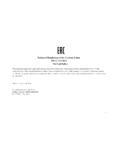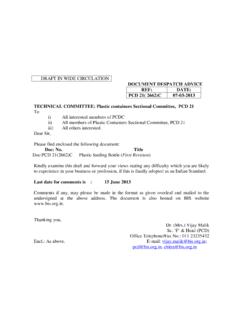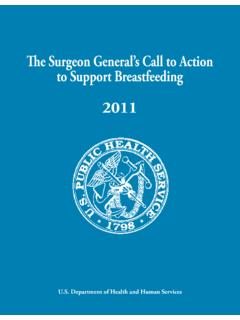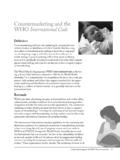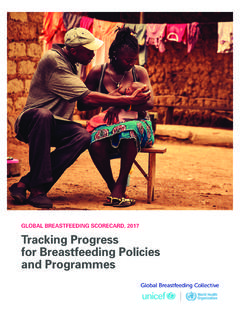Transcription of REASTFEEDING: FOUNDATION FOR A HEALTHY FUTURE
1 BREASTFEEDING: FOUNDATION FOR A HEALTHY FUTUREUNICEF/92-0384/LemoyneA family affair: A father admireshis newborn in aNew York City hospital, wherethe 'rooming-in'policy encouragesbreastfeeding every baby were exclusively breastfed frombirth, an estimated million lives would be saved each year. And not just saved, butenhanced, because breastmilk is the perfect food for a baby s first six months of life nomanufactured product can equal all children benefit from breast-feeding, regardless of where they live. Breastmilkhas all the nutrients babies need to stay healthyand grow. It protects them from diarrhoea and acute respiratory infections two leadingcauses of infant death. It stimulates theirimmune systems and response to contains hundreds of health-enhancing antibodies and enzymes. It requires no mixing,sterilization or equipment. And it is always the right who are breastfed have lower rates of childhood cancers, including leukaemiaand lymphoma.
2 They are less susceptible topneumonia, asthma, allergies, childhood diabetes, gastrointestinal illnesses and infectionsthat can damage their hearing. Studies suggestthat breastfeeding is good for neurological breastfeeding offers a benefit that cannotbe measured: a natural opportunity to commu-nicate love at the very beginning of a child s provides hours of closeness andnurturing every day, laying the FOUNDATION for a caring and trusting relationship betweenmother and motherbreastfeeds herchild under theprotection of amosquito net inZambia, whereabout 43 percent of childrenare still breast-feeding at theage of 20 to23 months. THE BEST START TO LIFEUNICEF/98-1009/PirozziSupports the right to nutritionChildren have a right to good nutrition. TheConvention on the Rights of the Child, ratified by allbut two nations, specifically calls for informing all seg-ments of society about child health and nutrition,including the advantages of breastfeeding (article 24).
3 The Convention on the Elimination of All Forms ofDiscrimination against Women (CEDAW) specifies thatStates parties mustensure appropriateservices in connec-tion with pregnancy,confinement and thepost-natal period ..as well as adequatenutrition duringpregnancy and lacta-tion (article 12).As of July 1999,163 countries hadratified money Breastfeeding saves money. It eliminates the expense of infant formula and the incalculable cost in money,time, energy and suffering caused by illness and death resulting from artificial feeding. The cost ofcommercial breastmilk substitutes is unaffordable forthe vast majority of families in the developing world: In Uganda, the average annual cost of formula forone child is more than the average annual income ofa village family. In Peru, the cost of one year s worth of breastmilksubstitutes exceeds the household income ofmore than half of the country s in emergen-cies, childrenhave a right to thegood nutritionbreastfeedingprovides, andmaintainingbreastfeeding intimes of crisishelps babies sur-vive.
4 After fleeingthe violence inKosovo, twowomen tend theirnewborns inAlbania. BREASTFEEDING:UNICEF/98-0285/Lemoyne In Viet Nam, the cost of a year s supply of breastmilksubstitutes is $257 compared to the country s per capita gross national product (GNP) of $ who breastfeed, however, need only about 500 additional calories a day the equivalent of a teaspoon of oil, some extra beans and half a breastfeeding mothers have more time to spendwith their health care spending The purchase of breastmilk substitutes is especiallydamaging to the economies of developing breastmilk substitutes are bought with scarceforeign exchange, siphoning it away from vital priori-ties. In Pakistan, for example, expenditures on importedformula grew from $4 million in 1982-83 to almost $44 million by helps cut costs for families and coun-tries, by eliminating the expense of infant formula andsaving health care and other costs: Jos Fabella Hospital in the Philippines saved more than $100,000 8 per cent of its annual budget within one year after initiating promotionof exclusive breastfeeding for newborns.
5 In north-eastern Brazil, administrators at AcariHospital estimated that, less than two years after initiating breastfeeding promotion, it had saved $20,000. In the Netherlands, a study by the University ofAmsterdam showed that a 5 per cent increase inbreastfeeding would save almost $850,000 perfectfood forbabies, alwaysavailable amother breast-feeds her childin a field inPeru, where thecost of breast-milk substitutesexceeds thehouseholdincome of halfthe population. UNICEF/93-0688/HornerSaves resourcesBreastfeeding preserves valuable resources,including safe water, fuel and time. Artificiallyfeeding a baby requires three litres of water perday one litre to mix with formula and twolitres to sterilize the bottles and teats. If water isboiled over a wood fire once a day, more than 73 kg of wood are required during the course ofa year. The burden of collecting wood and waterand preparing the formula typically falls onwomen, further cutting into the time available tocare for their children and for other families with child spacing Acceptable to all religions, exclusive breastfeedingprevents many pregnancies and in some settingsis the principal means of child spacing.
6 By delay-ing the resumption of ovulation after childbirth,frequent and vigorous suckling provides morethan 98 per cent protection from pregnancy dur-ing the first six months of breastfeeding. The livesof countless children have been saved as a result,because those born soon after a previous birth areat greater risk of dying before the age of RISE IN EXCLUSIVE BREASTFEEDINGB abies should beexclusively breastfed meaning that theyreceive nothing butbreastmilk, not evenwater for about thefirst six months of in the rarestcases, no additionalfoods or fluids are necessary, and theycan be harmful introducing germs, triggering allergies and filling the stomachso that the infant takesless shouldbe sustained until the baby is at least two years old, butbeginning at about six months breastmilkshould be complement-ed with appropriatesolid foods. Surveys in 35 develop-ing countries revealthat the percentage ofinfants exclusivelybreastfed for the firstfour months of life ison the rise.
7 Rates ofexclusive breastfeed-ing have increased in21 countries, declinedin 6 countries andstayed the same in 8 countries. Breastfeeding: Top 10 countries**Per cent of babies exclusively breastfed (under four months old).0 10 203040506070809010093%90%89%83%77%76%75% 74%70%66%MongoliaRwandaBurundiNepalChile CubaPapua New GuineaEthiopiaUgandaEritreaTHE BABY-FRIENDLY HOSPITAL INITIATIVET rained withUNICEF assis-tance, a nurse in Shanghai(China) helps amother learnbreastfeedingtechnique at theInternationalPeace, Maternityand and maternity units set a powerful Baby-Friendly Hospital Initiative (BFHI), launchedin 1992, is an effort by UNICEF and the World HealthOrganization (WHO) to ensure that all hospitalsbecome centres of breastfeeding hospital is designated baby-friendly when it hasagreed not to accept free or low-cost breastmilk substi-tutes, feeding bottles or teats, and to implement 10 spe-cific steps to support breastfeeding.
8 (See box, Ten Stepsto Successful Breastfeeding .) Since the Initiative began,nearly 15,000 hospitals in 128 developing and indus-trialized countries have been awarded baby-friendlystatus. In many areas where hospitals have been desig-nated baby-friendly, more mothers are breastfeedingtheir infants, and child health has improved. In Cuba, where 49 of the country s 56 hospitals andmaternity facilities are baby-friendly, the rate ofexclusive breastfeeding at four months almosttripled in six years from 25 per cent in 1990 to 72 per cent in 1996. In the first two years of BFHI implementation at the Central Hospital of Libreville in Gabon, officialsestimated that cases of neonatal diarrhoea fell by 15 per cent, diarrhoeal dehydration declined by14 per cent and mortality fell by 8 per cent. In China, which now has more than 6,000 Baby-Friendly Hospitals, exclusive breastfeeding in ruralareas rose from 29 per cent in 1992 to 68 per cent in 1994; in urban areas, the increase was from 10 per cent to 48 per facility providing maternity services andcare for newborn infants should: 1.
9 Have a written breastfeeding policy that is rou-tinely communicated to all health care Train all health care staff in skills necessary toimplement this policy. 3. Inform all pregnant women about the benefitsand management of Help mothers initiate breastfeeding within onehalf-hour of Show mothers how to breastfeed and maintainlactation, even if they should be separatedfrom their Give newborn infants no food or drink otherthan breastmilk, unless Practise rooming in that is, allow mothersand infants to remain together 24 hours a Encourage breastfeeding on demand. 9. Give no artificial teats or pacifiers (also calleddummies or soothers) to breastfeeding Foster the establishment of breastfeedingsupport groups and refer mothers to them ondischarge from the hospital or clinic. A Baby-Friendly Hospital does not accept free or low-cost breastmilk substitutes , feeding bottlesor teats, and implements these Ten Steps to support breastfeeding.
10 6 Images cut acrosslanguage keeping with the'Ten Steps', this signdeclares a Thaimaternity ward to bea 'milk powder-freezone .TEN STEPS TO SUCCESSFUL BREASTFEEDINGUNICEF/5479/LemoyneBreastmi lk substitutes are an expensive, inferior andoften dangerous substitute for breastmilk, but formulamanufacturers have nonetheless aggressively advertisedand marketed them. Recognizing the need to regulatethese practices, in 1981 the World Health Assembly(WHA) adopted the International Code of Marketing of Breast-milk substitutes . It sets out the responsibilitiesof companies, health workers, governments and con-cerned organizations with regard to the marketing ofbreastmilk substitutes , feeding bottles or Code stipulates that there should be absolutelyno promotion of breastmilk substitutes , bottles and teatsto the general public; neither health facilities nor healthprofessionals should ever have a role in promotingbreastmilk substitutes ; and free samples should not beprovided to pregnant women, new mothers or theirfamilies.











